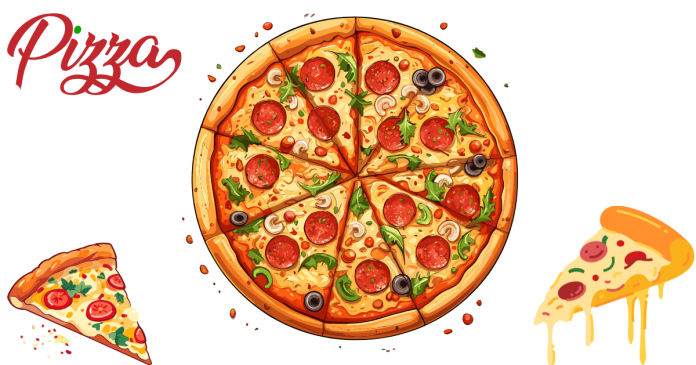Pizza is one of the most beloved foods worldwide. Its irresistible combination of crispy crust, gooey cheese, and flavorful toppings makes it a go-to comfort food. But if you’ve ever looked at the calorie count for a single slice, you might have been shocked—sometimes one slice can pack in 300 to 800 calories or more. How does such a seemingly simple food pack so much energy into one slice? Let’s break it down.
The Anatomy of a Pizza Slice
Understanding the calorie content in a slice of pizza comes down to its main components: crust, sauce, cheese, and toppings. Here’s how each element contributes to the calorie count:
- The Crust
- The crust is often made from refined flour, which is high in carbohydrates.
- A thicker crust or stuffed crust can significantly increase the calorie count.
- For example, a thin-crust slice might have fewer calories compared to a deep-dish or pan pizza.
- The Cheese
- Cheese is one of the most calorie-dense ingredients on a pizza. A single slice can have multiple layers of cheese, often containing high amounts of fat.
- Just one ounce of mozzarella has about 85–100 calories, and most slices have much more than an ounce of cheese.
- The Sauce
- While tomato-based pizza sauce isn’t a calorie bomb, it often contains added sugars and oils that can sneak in extra calories.
- Cream-based sauces (like Alfredo or white sauce) are much higher in calories.
- The Toppings
- Meats like pepperoni, sausage, and bacon are high in calories and saturated fats. Just a few slices of pepperoni can add an extra 100–150 calories.
- Veggie toppings are lower in calories but usually play a smaller role in most pizzas.
- Gourmet pizzas with toppings like extra cheese, truffle oil, or specialty meats can easily escalate the calorie count.
Why Are Some Slices Higher in Calories Than Others?
- Portion Size
- The size of the slice matters. A large New York-style slice is often much bigger than a small thin-crust slice from a local pizzeria.
- Type of Pizza
- Thin Crust: Fewer calories due to less dough.
- Deep-Dish or Pan Pizza: More dough, often cooked with oil or butter, increasing calorie density.
- Stuffed Crust: Adds layers of cheese inside the crust, significantly increasing calories.
- Chain vs. Homemade Pizza
- Pizza from chains like Domino’s, Pizza Hut, or Costco is designed to taste indulgent, often using more cheese, oils, and processed meats.
- Homemade pizza can be controlled for calories by using whole-grain crusts, light cheese, and fresh toppings.
- Cooking Method
- Pizza cooked in a wood-fired oven often has a slightly charred, thinner crust, making it less calorie-dense.
- Pizzas baked in pans coated with oil or butter add extra calories.
How Calories Add Up in Popular Pizza Styles
| Pizza Type | Calories Per Slice (Approx.) |
|---|---|
| Cheese Pizza (Thin Crust) | 200–300 calories |
| Pepperoni Pizza (Regular Crust) | 300–400 calories |
| Deep-Dish Pizza | 400–600+ calories |
| Stuffed Crust Pizza | 500–800+ calories |
| Costco Pizza Slice | 760 calories |
Why Is Pizza So Calorie-Dense?
- Calorie-Dense Ingredients
Cheese, meats, and oils are rich in fat, which provides 9 calories per gram (compared to 4 calories per gram from carbs or protein). - Refined Carbohydrates
The dough is made from refined flour, which is high in carbs but low in fiber, making it easy to eat large quantities without feeling full. - Portion Sizes Are Misleading
A single slice might not seem like much, but when you factor in the weight of the cheese and toppings, the calories quickly add up. - Highly Processed Ingredients
Many chain restaurants use processed ingredients, such as pre-shredded cheese coated with anti-caking agents, which can add hidden calories. - Psychological Factors
Pizza is designed to be hyper-palatable, meaning it’s hard to stop at just one slice. This makes overindulgence common, compounding the calorie intake.
Can You Make Pizza Healthier?
While pizza will always have a certain calorie baseline, there are ways to enjoy it without the guilt:
- Choose a Thin Crust:
Save hundreds of calories by opting for thin crust over thick or stuffed crust. - Go Light on Cheese:
Request light cheese or try lower-fat alternatives. - Pile on Veggies:
Add fiber-rich vegetables to increase satiety while keeping calories low. - Skip High-Calorie Meats:
Choose lean proteins like grilled chicken or stick to veggie options. - Watch Portion Sizes:
Stick to one or two slices and pair them with a salad or veggie side. - DIY Pizza:
Make pizza at home using whole-grain crust, fresh tomato sauce, and portion-controlled toppings.
Pizza’s high calorie count isn’t a mystery—it’s the result of calorie-dense ingredients like cheese, refined flour, and fatty meats, combined with larger portion sizes and indulgent cooking methods. While it’s okay to indulge occasionally, being mindful of portion sizes and ingredient choices can help you enjoy pizza without derailing your health goals. So, the next time you dig into a slice, savor it—because those calories are working overtime to deliver flavor and satisfaction!



